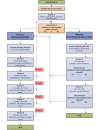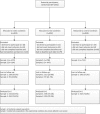Comparison of text and video computer-tailored interventions for smoking cessation: randomized controlled trial
- PMID: 24589938
- PMCID: PMC3961744
- DOI: 10.2196/jmir.3016
Comparison of text and video computer-tailored interventions for smoking cessation: randomized controlled trial
Abstract
Background: A wide range of effective smoking cessation interventions have been developed to help smokers to quit. Smoking rates remain high, especially among people with a lower level of education. Multiple tailoring adapted to the individual's readiness to quit and the use of visual messaging may increase smoking cessation.
Objective: The results of video and text computer tailoring were compared with the results of a control condition. Main effects and differential effects for subgroups with different educational levels and different levels of readiness to quit were assessed.
Methods: During a blind randomized controlled trial, smokers willing to quit within 6 months were assigned to a video computer tailoring group with video messages (n=670), a text computer tailoring group with text messages (n=708), or to a control condition with short generic text advice (n=721). After 6 months, effects on 7-day point prevalence abstinence and prolonged abstinence were assessed using logistic regression analyses. Analyses were conducted in 2 samples: (1) respondents (as randomly assigned) who filled in the baseline questionnaire and completed the first session of the program, and (2) a subsample of sample 1, excluding respondents who did not adhere to at least one further intervention session. In primary analyses, we used a negative scenario in which respondents lost to follow-up were classified as smokers. Complete case analysis and multiple imputation analyses were considered as secondary analyses.
Results: In sample 1, the negative scenario analyses revealed that video computer tailoring was more effective in increasing 7-day point prevalence abstinence than the control condition (OR 1.45, 95% CI 1.09-1.94, P=.01). Video computer tailoring also resulted in significantly higher prolonged abstinence rates than controls among smokers with a low (ready to quit within 4-6 months) readiness to quit (OR 5.13, 95% CI 1.76-14.92, P=.003). Analyses of sample 2 showed similar results, although text computer tailoring was also more effective than control in realizing 7-day point prevalence abstinence. No differential effects were found for level of education. Complete case analyses and multiple imputation yielded similar results.
Conclusions: In all analyses, video computer tailoring was effective in realizing smoking cessation. Furthermore, video computer tailoring was especially successful for smokers with a low readiness to quit smoking. Text computer tailoring was only effective for sample 2. Results suggest that video-based messages with personalized feedback adapted to the smoker's motivation to quit might be effective in increasing abstinence rates for smokers with diverse educational levels.
Trial registration: Netherlands Trial Register: NTR3102; http://www.trialregister.nl/trialreg/admin/rctview.asp?TC=3102 (Archived by WebCite at http://www.webcitation.org/6NS8xhzUV).
Keywords: delivery strategy; educational level; multiple computer tailoring; smoking cessation; text messages; video messages.
Conflict of interest statement
Conflicts of Interest: Hein de Vries is scientific director of Vision2-Health, a company that licenses evidence-based computer-tailored health communication tools.
Figures


References
-
- Liu Z, Verplanken B, Orbell S. Reading behavior in the digital environment: Changes in reading behavior over the past ten years. Journal of Documentation. 2005 Jun;61(6):700–712. doi: 10.1108/00220410510632040. - DOI
-
- Nagelhout GE, de Korte-de Boer D, Kunst AE, van der Meer RM, de Vries H, van Gelder BM, Willemsen MC. Trends in socioeconomic inequalities in smoking prevalence, consumption, initiation, and cessation between 2001 and 2008 in the Netherlands. Findings from a national population survey. BMC Public Health. 2012;12:303. doi: 10.1186/1471-2458-12-303. http://www.biomedcentral.com/1471-2458/12/303 - DOI - PMC - PubMed
-
- Hiscock R, Judge K, Bauld L. Social inequalities in quitting smoking: what factors mediate the relationship between socioeconomic position and smoking cessation? J Public Health (Oxf) 2011 Mar;33(1):39–47. doi: 10.1093/pubmed/fdq097. http://jpubhealth.oxfordjournals.org/cgi/pmidlookup?view=long&pmid=21178184 - DOI - PubMed
-
- Kotz D, West R. Explaining the social gradient in smoking cessation: it's not in the trying, but in the succeeding. Tob Control. 2009 Feb;18(1):43–6. doi: 10.1136/tc.2008.025981. http://tobaccocontrol.bmj.com/cgi/pmidlookup?view=long&pmid=18936053 - DOI - PubMed
Publication types
MeSH terms
Associated data
LinkOut - more resources
Full Text Sources
Other Literature Sources
Medical

